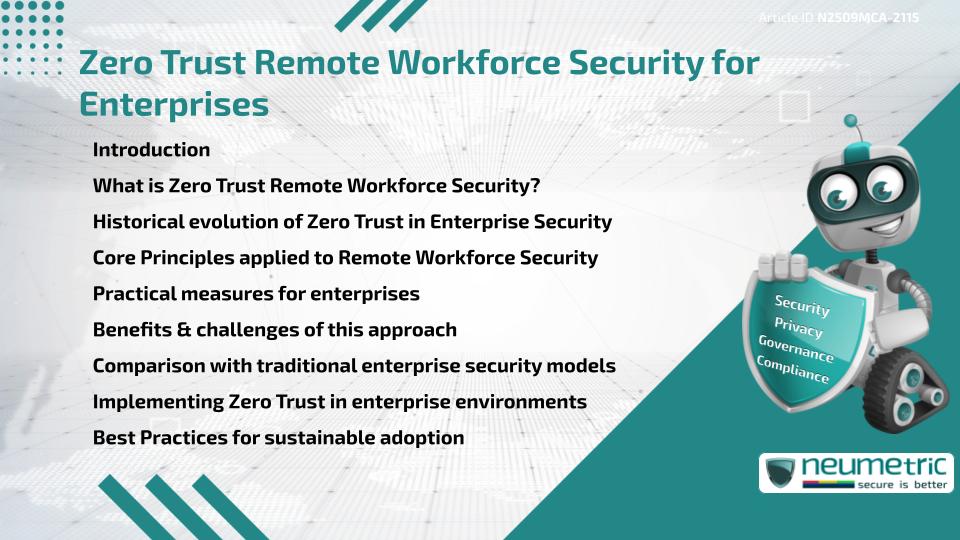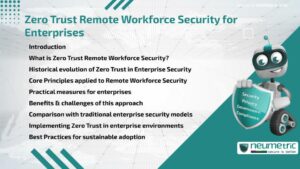Table of Contents
ToggleIntroduction
Zero Trust Remote Workforce Security is a Security Framework designed to protect enterprises in an era where Employees increasingly work outside traditional office boundaries. The model rejects the idea of automatic trust based on network location & instead demands continuous verification of every user, device & connection. For enterprises managing distributed teams, Zero Trust Remote Workforce Security ensures that Sensitive Data & applications remain secure regardless of where Employees work. It helps Organisations reduce Risks of unauthorised access, comply with regulations & maintain User trust in today’s hybrid workplace.
What is Zero Trust Remote Workforce Security?
Zero Trust Remote Workforce Security is a proactive security model based on the principle of “never trust, always verify”. Unlike older systems that assumed users inside a corporate network were trustworthy, Zero Trust requires strict identity verification & device validation for every request.
Think of it like Airport Security: even if someone works at the airport, they still go through checkpoints every time they enter secure areas. Similarly, Zero Trust ensures Employees must prove their Identity & device Integrity whenever they access enterprise resources.
Historical evolution of Zero Trust in Enterprise Security
The concept of Zero Trust originated in the late 2000s & was popularised by Forrester Research. Soon after, the National Institute of Standards & Technology [NIST] released detailed guidelines for implementing Zero Trust architectures.
As Cloud Computing, Mobile Workforces & Cyber Threats expanded, enterprises realised that perimeter-based security was no longer sufficient. The rise of Remote Work during the COVID-19 Pandemic accelerated adoption, making Zero Trust Remote Workforce Security a cornerstone of modern enterprise strategies.
Core Principles applied to Remote Workforce Security
Zero Trust Remote Workforce Security relies on several Core Principles:
- Continuous verification of User Identity & Device Health
- Least privilege access, ensuring Employees access only what they need
- Micro-Segmentation to isolate applications & data
- End-to-end Encryption for communications
- Real-time monitoring & logging for Threat detection
- Strong authentication such as Multi-Factor Authentication [MFA]
These principles collectively help enterprises minimise attack surfaces & prevent lateral movement by malicious actors.
Practical measures for enterprises
Enterprises adopting Zero Trust Remote Workforce Security can apply practical measures such as:
- Deploying Single Sign-On [SSO] solutions combined with MFA
- Enforcing strict Endpoint Security Policies on remote devices
- Using Cloud Access Security Brokers to manage SaaS application usage
- Monitoring User Behavior Analytics for anomalies
- Implementing Virtual Private Networks with Zero Trust access Policies
For example, an enterprise managing remote Finance teams might require Employees to log in with MFA, connect via secure tunnels & use encrypted document sharing platforms.
Benefits & challenges of this approach
The benefits of Zero Trust Remote Workforce Security include stronger protection against data breaches, enhanced visibility into User activity & reduced Risk of insider Threats. It also improves Compliance with regulations like the General Data Protection Regulation [GDPR] & the Health Insurance Portability & Accountability Act [HIPAA].
However, challenges exist. Deploying Zero Trust requires investments in infrastructure, skilled staff & cultural changes across enterprises. Employees may initially find stricter authentication processes inconvenient. Moreover, legacy applications that do not support Zero Trust principles can complicate integration.
Comparison with traditional enterprise security models
Traditional enterprise security models rely heavily on the network perimeter. Once a User gains access to the corporate network, they are often trusted to move freely. This approach leaves enterprises vulnerable to internal Threats & compromised accounts.
Zero Trust Remote Workforce Security eliminates this weakness by assuming every request could be malicious. It verifies each access attempt in real time, making it much harder for attackers to exploit stolen credentials or compromised devices. The difference is similar to leaving a house key under the mat versus installing Smart Locks that require Biometric Verification every time.
Implementing Zero Trust in enterprise environments
For enterprises transitioning to Zero Trust Remote Workforce Security, implementation involves several steps:
- Conducting Risk Assessments to identify Critical Assets
- Defining User & device access Policies
- Deploying Identity & Access Management platforms
- Segmenting networks & restricting lateral movement
- Integrating Security Analytics for Continuous Monitoring
Successful adoption also requires collaboration between IT teams, Security Leaders & Business Units to align technical & organisational goals.
Best Practices for sustainable adoption
Enterprises seeking long-term success with Zero Trust Remote Workforce Security should follow Best Practices such as:
- Continuously updating identity & device verification standards
- Training Employees on secure authentication practices
- Automating policy enforcement to reduce human error
- Regularly auditing systems for Compliance gaps
- Partnering with trusted vendors that provide Zero Trust solutions
By embedding these practices into their security strategy, enterprises can ensure resilience in a rapidly changing Threat landscape.
Takeaways
- Zero Trust Remote Workforce Security provides continuous verification for every User & Device.
- It helps enterprises secure Sensitive Data across hybrid & remote environments.
- While implementation requires investment & cultural change, it reduces insider & external Threats.
- Enterprises adopting Zero Trust align with Regulatory & Compliance frameworks.
FAQ
What is Zero Trust Remote Workforce Security?
It is a Framework that requires continuous identity & device verification to protect enterprise resources for remote teams.
Why do enterprises need Zero Trust Remote Workforce Security?
It prevents unauthorised access, reduces data breach Risks & supports Compliance with global regulations.
How is Zero Trust different from traditional security?
Traditional models rely on network trust, while Zero Trust verifies every request regardless of location.
What are the main challenges in implementing Zero Trust?
Challenges include costs, Employee adoption, legacy system compatibility & the need for specialised expertise.
Does Zero Trust Remote Workforce Security slow down productivity?
When implemented effectively with automation, it balances security with usability, minimising workflow disruption.
Is Zero Trust required by Compliance frameworks?
While not always mandated, frameworks like NIST, GDPR & HIPAA encourage or align closely with Zero Trust principles.
How can enterprises begin adopting Zero Trust?
They should start with Risk Assessments, implement MFA, define access Policies & roll out Zero Trust tools gradually.
Need help for Security, Privacy, Governance & VAPT?
Neumetric provides organisations the necessary help to achieve their Cybersecurity, Compliance, Governance, Privacy, Certifications & Pentesting needs.
Organisations & Businesses, specifically those which provide SaaS & AI Solutions in the Fintech, BFSI & other regulated sectors, usually need a Cybersecurity Partner for meeting & maintaining the ongoing Security & Privacy needs & requirements of their Enterprise Clients & Privacy conscious Customers.
SOC 2, ISO 27001, ISO 42001, NIST, HIPAA, HECVAT, EU GDPR are some of the Frameworks that are served by Fusion – a SaaS, multimodular, multitenant, centralised, automated, Cybersecurity & Compliance Management system.
Neumetric also provides Expert Services for technical security which covers VAPT for Web Applications, APIs, iOS & Android Mobile Apps, Security Testing for AWS & other Cloud Environments & Cloud Infrastructure & other similar scopes.
Reach out to us by Email or filling out the Contact Form…





